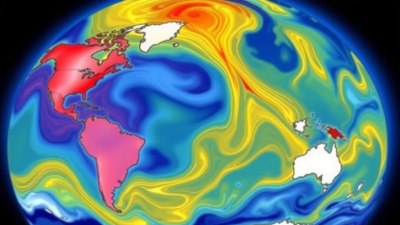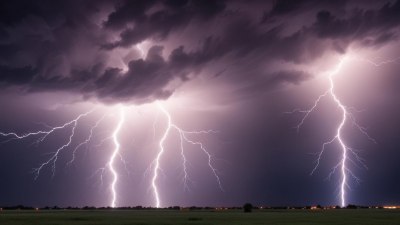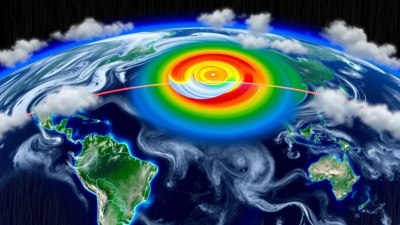How Warm Ocean Currents Affect Inland Weather
Explore how warm ocean currents influence climate patterns and weather conditions far inland through atmospheric interactions and moisture transport.

Image created with Flux Schnell
Ocean currents play a pivotal role in regulating the Earth's climate by redistributing heat across the globe. Among these, warm ocean currents are especially influential not only in shaping coastal weather but also in affecting atmospheric conditions far inland. Understanding how warm currents influence inland weather requires an examination of the mechanisms by which they transfer heat and moisture into the atmosphere and how these factors interact with continental climates.
The Nature of Warm Ocean Currents
Warm ocean currents are bodies of seawater that move continuously on the surface of the oceans, carrying warmer temperatures from equatorial regions towards higher latitudes. Examples include the Gulf Stream in the North Atlantic Ocean, the Kuroshio Current in the Pacific Ocean, and the East Australian Current in the Southern Hemisphere. These currents are driven by various factors such as prevailing winds, Earth’s rotation (the Coriolis effect), and differences in water density.
These currents raise the temperature of the atmosphere above them, creating zones of higher humidity and often promoting cloud formation and precipitation. While their direct effects are most evident along coastal regions, the influence of warm ocean currents extends far inland through complex atmospheric processes.
Heat Transfer and Atmospheric Circulation
Warm ocean currents act as heat conveyors from tropical to temperate and polar regions. This heat transfer impacts atmospheric pressure systems and wind patterns. For example, the warm waters of the Gulf Stream raise air temperatures and humidity levels along the eastern coast of North America, which in turn can influence weather patterns hundreds of kilometers inland.
When warm, moist air masses move from oceanic regions onto continents, they can lead to milder winters and increased precipitation inland. This effect is especially pronounced in areas downwind of warm currents, where prevailing winds carry moisture inland. Consequently, regions that might otherwise experience colder and drier conditions can have relatively temperate climates with more abundant rainfall.
Impact on Seasonal Weather Variability
Warm ocean currents also contribute to seasonal weather variations. In winter, the heat retained and transported by these currents can prevent extreme cold in adjacent inland areas. For instance, western Europe benefits from the Atlantic's warm currents, which moderate the climate and prevent severe cold snaps that would otherwise be typical at that latitude.
Similarly, during summer, the warm ocean surface can enhance evaporation, feeding moisture into the atmosphere and potentially increasing inland thunderstorm activity. This moisture influx can influence the onset and intensity of monsoon systems and other seasonal rainfall patterns, thereby affecting agriculture and water resources far from the coast.
Moisture Transport and Precipitation Patterns
One of the primary ways warm ocean currents affect inland weather is through moisture transport. As warm currents increase local evaporation rates, the atmosphere above becomes laden with water vapor. This humid air can be advected inland by prevailing winds, contributing to cloud formation and precipitation over land.
For example, the Gulf Stream's warm waters increase humidity in the southeastern United States, often leading to increased rainfall as moist air interacts with topography and frontal systems. Over time, this process can significantly alter soil moisture levels, river flows, and even ecosystem health far from the coastline.
Influence on Extreme Weather Events
Warm ocean currents can also influence the frequency and intensity of extreme weather events inland. The added heat and moisture supplied by these currents can fuel storms, including hurricanes and severe thunderstorms. Hurricanes often draw their energy from warm ocean waters, but as these storms move inland, the residual heat and moisture can sustain intense rainfall, causing flooding and other hazards in regions that are not immediately adjacent to the coast.
Moreover, the atmospheric patterns generated by warm currents can steer storm tracks further inland or modify their trajectories, exposing a broader geographical area to extreme weather impacts.
Effects on Temperature Extremes and Climate Anomalies
Warm ocean currents contribute to reducing temperature extremes in adjacent landmasses. By moderating cold air outbreaks in winter, they create climates that support diverse flora and fauna and human habitation in regions that might otherwise be inhospitable. Conversely, anomalies in these currents, such as those caused by climate phenomena like El Niño, can disrupt normal weather patterns leading to droughts or excessive rains inland.
El Niño events, characterized by the warming of central and eastern Pacific Ocean waters, affect global atmospheric circulation patterns, including those over continents. This can result in warmer winters or increased precipitation in certain inland regions while causing droughts in others, illustrating the strong influence oceanic warmth has on terrestrial climates.
Role in Regional Climate Systems
Beyond immediate weather changes, warm ocean currents shape regional climate systems over longer time scales. Their influence is evident in the formation of urban heat islands, agricultural zones, and natural ecosystems that evolve in response to the moderated climate conditions enabled by adjacent warm currents.
This influence extends to planning and development, as understanding the interplay between oceanic currents and inland weather assists in infrastructure development, water resource management, and disaster preparedness strategies.
Interplay with Topography and Continental Features
The effects of warm ocean currents on inland weather are often modified by topography and land surface features. Mountain ranges, valleys, and plains influence how moisture and heat carried by atmospheric currents are distributed. For example, mountain ranges can force moist air to rise, cooling it and triggering precipitation on windward slopes while creating rain shadows on the leeward sides.
Similarly, large inland bodies of water, forests, and urban areas interact with the atmospheric effects initiated by warm ocean currents, sometimes enhancing or dampening their influence on local weather conditions.
Impact on Agriculture and Ecosystems
The shifts in inland weather caused by warm ocean currents have direct implications for agriculture and natural ecosystems. Increased rainfall and milder temperatures can extend growing seasons and improve crop yields in some regions. Conversely, disruptions to these patterns may cause stress on water supplies or increase the vulnerability to pests and diseases.
Understanding these influences helps farmers and conservationists anticipate changes and adapt practices to maintain productivity and biodiversity in changing climates.
Scientific Studies and Observations
Numerous scientific studies employing satellite data, weather modeling, and field observations have highlighted the connections between warm ocean currents and inland weather. These studies demonstrate correlations between shifts in current strength, position, and temperature and subsequent changes in rainfall patterns, temperature anomalies, and storm activity far from the ocean.
Continuous monitoring and research remain essential as global climate change alters ocean currents and their cascading effects on weather and climate systems worldwide.
Warm ocean currents are far more than coastal phenomena. Their ability to redistribute heat and moisture has profound effects on inland weather patterns, influencing temperature, precipitation, storm activity, and broader climate conditions. Through atmospheric circulation, moisture transport, and interaction with geographical features, these currents help shape the environments in which people live and ecosystems thrive. As climates continue to evolve, understanding the role of warm ocean currents remains vital for predicting weather, managing natural resources, and preparing for environmental changes.











